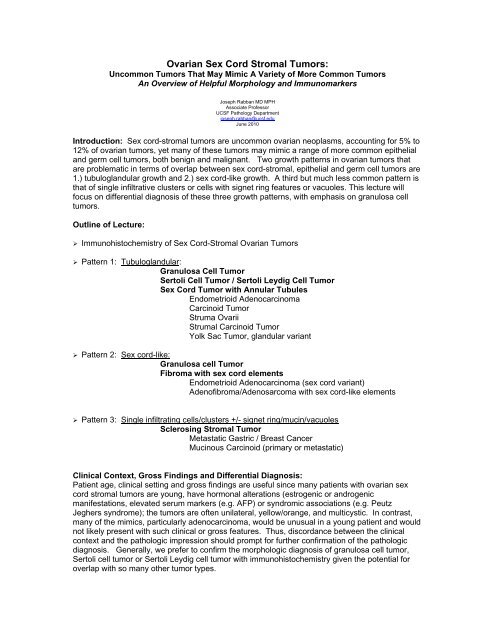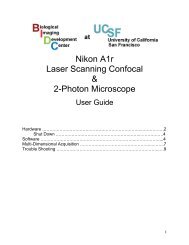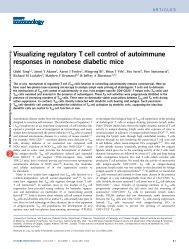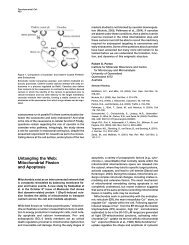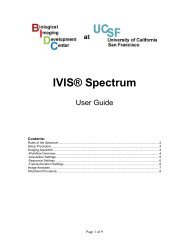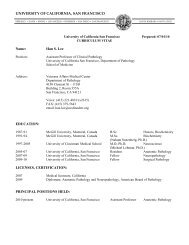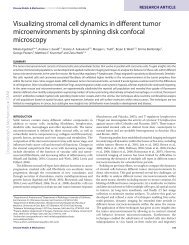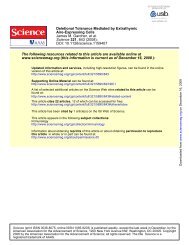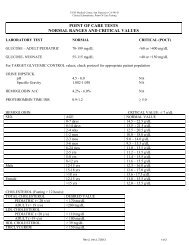Ovarian Sex Cord Stromal Tumors: - Departments of Pathology and ...
Ovarian Sex Cord Stromal Tumors: - Departments of Pathology and ...
Ovarian Sex Cord Stromal Tumors: - Departments of Pathology and ...
Create successful ePaper yourself
Turn your PDF publications into a flip-book with our unique Google optimized e-Paper software.
<strong>Ovarian</strong> <strong>Sex</strong> <strong>Cord</strong> <strong>Stromal</strong> <strong>Tumors</strong>:<br />
Uncommon <strong>Tumors</strong> That May Mimic A Variety <strong>of</strong> More Common <strong>Tumors</strong><br />
An Overview <strong>of</strong> Helpful Morphology <strong>and</strong> Immunomarkers<br />
Joseph Rabban MD MPH<br />
Associate Pr<strong>of</strong>essor<br />
UCSF <strong>Pathology</strong> Department<br />
joseph.rabban@ucsf.edu<br />
June 2010<br />
Introduction: <strong>Sex</strong> cord-stromal tumors are uncommon ovarian neoplasms, accounting for 5% to<br />
12% <strong>of</strong> ovarian tumors, yet many <strong>of</strong> these tumors may mimic a range <strong>of</strong> more common epithelial<br />
<strong>and</strong> germ cell tumors, both benign <strong>and</strong> malignant. Two growth patterns in ovarian tumors that<br />
are problematic in terms <strong>of</strong> overlap between sex cord-stromal, epithelial <strong>and</strong> germ cell tumors are<br />
1.) tubulogl<strong>and</strong>ular growth <strong>and</strong> 2.) sex cord-like growth. A third but much less common pattern is<br />
that <strong>of</strong> single infiltrative clusters or cells with signet ring features or vacuoles. This lecture will<br />
focus on differential diagnosis <strong>of</strong> these three growth patterns, with emphasis on granulosa cell<br />
tumors.<br />
Outline <strong>of</strong> Lecture:<br />
‣ Immunohistochemistry <strong>of</strong> <strong>Sex</strong> <strong>Cord</strong>-<strong>Stromal</strong> <strong>Ovarian</strong> <strong>Tumors</strong><br />
‣ Pattern 1: Tubulogl<strong>and</strong>ular:<br />
Granulosa Cell Tumor<br />
Sertoli Cell Tumor / Sertoli Leydig Cell Tumor<br />
<strong>Sex</strong> <strong>Cord</strong> Tumor with Annular Tubules<br />
Endometrioid Adenocarcinoma<br />
Carcinoid Tumor<br />
Struma Ovarii<br />
Strumal Carcinoid Tumor<br />
Yolk Sac Tumor, gl<strong>and</strong>ular variant<br />
‣ Pattern 2: <strong>Sex</strong> cord-like:<br />
Granulosa cell Tumor<br />
Fibroma with sex cord elements<br />
Endometrioid Adenocarcinoma (sex cord variant)<br />
Aden<strong>of</strong>ibroma/Adenosarcoma with sex cord-like elements<br />
‣ Pattern 3: Single infiltrating cells/clusters +/- signet ring/mucin/vacuoles<br />
Sclerosing <strong>Stromal</strong> Tumor<br />
Metastatic Gastric / Breast Cancer<br />
Mucinous Carcinoid (primary or metastatic)<br />
Clinical Context, Gross Findings <strong>and</strong> Differential Diagnosis:<br />
Patient age, clinical setting <strong>and</strong> gross findings are useful since many patients with ovarian sex<br />
cord stromal tumors are young, have hormonal alterations (estrogenic or <strong>and</strong>rogenic<br />
manifestations, elevated serum markers (e.g. AFP) or syndromic associations (e.g. Peutz<br />
Jeghers syndrome); the tumors are <strong>of</strong>ten unilateral, yellow/orange, <strong>and</strong> multicystic. In contrast,<br />
many <strong>of</strong> the mimics, particularly adenocarcinoma, would be unusual in a young patient <strong>and</strong> would<br />
not likely present with such clinical or gross features. Thus, discordance between the clinical<br />
context <strong>and</strong> the pathologic impression should prompt for further confirmation <strong>of</strong> the pathologic<br />
diagnosis. Generally, we prefer to confirm the morphologic diagnosis <strong>of</strong> granulosa cell tumor,<br />
Sertoli cell tumor or Sertoli Leydig cell tumor with immunohistochemistry given the potential for<br />
overlap with so many other tumor types.
Immunohistochemistry<br />
Inhibin <strong>and</strong> calretinin are the traditional markers <strong>of</strong> ovarian sex cord-stromal differentiation.<br />
Expression tends to be stronger <strong>and</strong> more diffuse in granulosa cell tumors, Sertoli <strong>and</strong> Sertoli-<br />
Leydig cell tumors than in fibroma or thecoma. <strong>Ovarian</strong> steroid cell tumors will also mark with<br />
inhibin <strong>and</strong> calretinin, as will ovarian hilus cells <strong>and</strong> cells <strong>of</strong> stromal hyperthecosis. Nuclear<br />
expression <strong>of</strong> WT1 <strong>and</strong> membrane expression <strong>of</strong> CD99 also characterize many sex cord-stromal<br />
tumors, but in our practice, we don’t use these markers since they are not as reliable as others in<br />
our laboratory. ER <strong>and</strong> PR may be expressed in many granulosa cell tumors. When trying to<br />
distinguish sex cord-stromal tumors from epithelial tumors, care must be exercised in selection <strong>of</strong><br />
epithelial markers: pan-keratin may mark granulosa cell tumors <strong>and</strong> Sertoli cell tumors to variable<br />
degrees <strong>and</strong> this may cause confusion with adenocarcinoma. EMA (epithelial membrane<br />
antigen) is a better choice since it is negative in sex cord-stromal tumors. Conversely, some<br />
endometrioid adenocarcinomas may express inhibin, calretinin or WT-1, albeit in a weak, patchy<br />
pattern.<br />
Steroidenic factor 1 (SF 1) is a recently studied nuclear protein that appears to be a useful marker<br />
<strong>of</strong> ovarian sex cord differentiation. It marks lesions <strong>of</strong> sex cord-stromal differentiation in a nuclear<br />
pattern <strong>and</strong> is negative in epithelial tumors. 56, 57 SF 1, also known as Adrenal Binding Protein 1,<br />
is found in many <strong>of</strong> the same tissues that mark with inhibin. SF 1 is a transcription factor<br />
regulating steroidogenesis <strong>of</strong> the adrenal <strong>and</strong> pituitary gl<strong>and</strong>s. Immunoexpression is observed in<br />
adrenal cortical tumors <strong>and</strong> pituitary adenoma. It is also thought that SF 1 is involved in gonadal<br />
development. In the testis, SF 1 marks Sertoli cells <strong>and</strong> Leydig cells. Recently it was<br />
demonstrated that SF 1 marks ovarian sex cord tumors (granulosa cell tumor, Sertoli cell tumor,<br />
Sertoli Leydig cell tumor, <strong>and</strong> fibroma/thecoma) but not endometrioid adenocarcinoma or<br />
56, 57<br />
carcinoid tumor. The nuclear expression pattern makes it a preferred marker.<br />
Recommended panel:<br />
To confirm a diagnosis <strong>of</strong> granulosa cell tumor, we prefer the quartet <strong>of</strong> SF-1, inhibin, calretinin<br />
<strong>and</strong> EMA <strong>and</strong> we avoid cytokeratin stains. The following table lists the results expected in most<br />
tumors, keeping in mind that exceptions do occur.<br />
Marker Granulosa Cell Sertoli Cell Endometrioid Carcinoid Struma<br />
Tumor Tumor Adenocarcinoma Tumor Ovarii<br />
SF-1 Positive Positive Negative Negative Negative<br />
Calretinin Positive Positive Negative Negative Negative<br />
Inhibin Positive Positive Negative Negative Negative<br />
WT-1 Positive Positive Rarely Negative Negative<br />
EMA Negative Negative Positive Rarely Positive<br />
Keratin Variable Positive Positive Positive Positive<br />
Chromogranin Negative Negative Negative Positive Negative<br />
TTF-1 Negative Negative Negative Negative Positive
Differential Diagnosis by Patterns<br />
PATTERN 1: TUBULOGLANDULAR GROWTH:<br />
Granulosa Cell Tumor versus Endometrioid Adenocarcinoma<br />
The micr<strong>of</strong>ollicular <strong>and</strong> solid pattern <strong>of</strong> granulosa cell tumor may resemble endometrioid<br />
adenocarcinoma. Morphologic features favoring granulosa cell tumor include nuclear grooves,<br />
Call-Exner bodies, a mixture <strong>of</strong> growth patterns including trabecular growth, <strong>and</strong> an absence <strong>of</strong><br />
squamous differentiation.<br />
Potential Pitfall: Nuclear grooves are not pathognomonic <strong>of</strong> granulosa cell tumor.<br />
Nuclear grooves may be seen endometrioid adenocarcinoma.<br />
Endometrioid adenocarcinoma is favored by the presence <strong>of</strong> endometrioid appearing cells <strong>and</strong><br />
squamous differentiation. In questionable cases, immunostains may be helpful (positive EMA,<br />
negative SF-1, calretinin, inhibin).<br />
Granulosa Cell Tumor versus Sertoli Cell Tumor<br />
Micr<strong>of</strong>ollicular growth in granulosa cell tumor may resemble the hollow packed tubules <strong>of</strong> Sertoli<br />
cell tumor, however the latter usually does not exhibit the mixed array <strong>of</strong> other growth patterns<br />
seen in granulosa cell tumor. In difficult cases, cytokeratin expression can be used to confirm a<br />
diagnosis <strong>of</strong> Sertoli cell tumor.<br />
Granulosa Cell Tumor versus Carcinoid Tumor<br />
Micr<strong>of</strong>ollicular <strong>and</strong> trabecular growth can be seen in both these tumors but the typical cytologic<br />
features <strong>of</strong> granulosa cell tumor (nuclear grooves, Call-Exner bodies) will not be seen in carcinoid<br />
tumor. Teratomatous elements favor a diagnosis <strong>of</strong> carcinoid tumor, as does the presence <strong>of</strong><br />
nuclei with neuroendocrine type chromatin texture (stippled or so-called salt <strong>and</strong> pepper texture).<br />
Neuroendocrine markers such as chromogranin <strong>and</strong> synaptophysin can be useful to identifiy<br />
carcinoid tumor.<br />
Granulosa Cell Tumor versus Struma Ovarii<br />
Micr<strong>of</strong>ollicular growth <strong>of</strong> granulosa cell tumor may sometimes resemble the follicles <strong>of</strong> struma<br />
ovarii but otherwise, each entity should show other morphology that clearly leads to the correct<br />
diagnosis. Struma ovarii may be accompanied by other teratomatous elements, something not<br />
expected in granulosa cell tumor. Generally the mixture <strong>of</strong> other growth patterns in the latter is<br />
not seen in struma ovarii. The nuclear shape may also helpful. Struma ovarii usually exhibits a<br />
uniform, monotonous round/oval nuclear shape without nuclear contour irregularities whereas<br />
most granulosa cell tumors show more nuclear atypia, folds, <strong>and</strong> grooves.<br />
Granulosa Cell Tumor versus gl<strong>and</strong>ular variant Yolk Sac Tumor<br />
Micr<strong>of</strong>ollicular <strong>and</strong> trabecular growth <strong>of</strong> granulosa cell tumor can resemble the gl<strong>and</strong>ular variant <strong>of</strong><br />
yolk sac tumor but, again, there are usually other morphologic findings that allow for a<br />
straightforward diagnosis. Yolk sac tumor <strong>of</strong>ten shows a mixture <strong>of</strong> growth patterns (i.e. reticular,<br />
papillary, solid, microcystic) <strong>and</strong> may be mixed with other germ cell tumor components that are<br />
not expected in granulosa cell tumor. Immunostaining for SALL-4, Glypican 3, AFP<br />
PATTERN 2: SEX CORD LIKE GROWTH<br />
Fibroma with sex cord elements versus Granulosa Cell Tumor<br />
Some fibromas may contain foci <strong>of</strong> sex cord elements. Typically these are microscopic foci <strong>and</strong><br />
only a few foci are present; this does not alter the behavior.
Conversely, some granulosa cell tumors may show a fascicular, spindled growth pattern that<br />
resembles thecoma or cellular fibroma. Though it is unusual for such a tumor to lack other<br />
distinctive patterns <strong>of</strong> granulosa cell tumor growth (such as micr<strong>of</strong>ollicular or trabecular), rare<br />
cases may be difficult to resolve based on morphology alone. Immunohistochemistry is not <strong>of</strong><br />
great value since calretinin, inhibin, WT-1, <strong>and</strong> SF 1 can be seen in both tumor groups. Reticulin<br />
staining, however, is useful. In granulosa cell tumor, the reticulin fibers will highlight bundles,<br />
fascicles <strong>and</strong> nests <strong>of</strong> tumor cells but the fibers will not surround individual cells. In contrast, the<br />
reticulin fibers will surround individual spindle cells.<br />
Aden<strong>of</strong>ibroma/Adenosarcoma with sex cord elements versus Granulosa Cell Tumor<br />
Similar to fibroma with sex cord elements, both aden<strong>of</strong>ibroma <strong>and</strong> adenosarcoma may contain<br />
these elements, typically in a microscopic amount. There usually is sufficient morphology present<br />
to easily make the diagnosis <strong>of</strong> aden<strong>of</strong>ibroma or adenosarcoma <strong>and</strong> these tumors are not<br />
typically confused with granulosa cell tumor. Behavior is not affected by sex cord elements.<br />
Endometrioid Adenocarcinoma, <strong>Cord</strong>ed <strong>and</strong> Hyalinized Variant, versus Granulosa Cell<br />
Tumor<br />
A rare variant <strong>of</strong> endometrioid adenocarcinoma <strong>of</strong> the ovary or uterus may contain a sex cord-like<br />
or sertoliform growth pattern that resembles granulosa cell tumor. 34 The unusual growth zones<br />
may be embedded in hyalinized stroma, thus giving the name “corded <strong>and</strong> hyalinized<br />
endometrioid adenocarcinoma”. Such tumors generally exhibit clear cut areas <strong>of</strong> typical<br />
endometrioid adenocarcinoma that allow for the correct diagnosis. However, we have<br />
encountered some cases that lack such areas <strong>and</strong> truly resemble granulosa cell tumor.<br />
Identification <strong>of</strong> squamous differentiation is a key clue to correctly diagnosis adenocarcinoma.<br />
Immunostaining can be helpful in difficult cases.<br />
PATTERN 3: INFILTRATING CLUSTERS/CELLS with SIGNET RING/MUCIN/VACUOLES<br />
Sclerosing stromal tumor versus metastatic carcinoma<br />
Lobular breast cancer <strong>and</strong> metastatic gastric carcinoma involving the ovary may grow as single<br />
infiltrating polygonal tumor cells embedded within fibrotic stroma, resembling a sclerosing stromal<br />
tumor. Such metastases generally lack the distinctive blood vessels <strong>and</strong> the pseudolobular growth<br />
pattern <strong>of</strong> sclerosing stromal tumor. In addition, clinical history <strong>of</strong> a primary gastrointestinal or breast<br />
cancer should be informative in the differential diagnosis. Because sclerosing stromal tumor affects<br />
young women, the likelihood <strong>of</strong> a metastatic cancer to the ovaries is comparatively low. EMA<br />
immunostaining should highlight metastatic carcinoma cells <strong>and</strong> confirm that diagnosis.<br />
Sclerosing stromal tumor versus mucinous carcinoid tumor<br />
A rare variant <strong>of</strong> carcinoid tumor is the mucinous carcinoid tumor, which may be primary to the ovary<br />
or metastatic. A range <strong>of</strong> growth patterns can be seen. Infiltrative dispersed clusters or single tumor<br />
cells with a mucin droplet or signet ring appearance may raise consideration <strong>of</strong> either sclerosing<br />
stromal tumor or metastatic mucinous/signet ring adenocarcinoma. Generally, however, there will be<br />
clear cut areas <strong>of</strong> carcinoid morphology in the tumor. Distinguishing primary versus metastatic origin<br />
<strong>of</strong> mucinous carcinoid is important; appendiceal origin or other intestinal origin should be considered.<br />
CK7 <strong>and</strong> CK20 may be helpful for that purpose. Keratin or EMA positivity will separate carcinoid<br />
from sclerosing stromal tumor, as will calretinin <strong>and</strong> inhibin.
SUMMARY OF TUMOR TYPES<br />
Granulosa Cell Tumor<br />
Granulosa cell tumors range from small incidentally discovered nodules only a few millimeter in<br />
diameter to large tumors more than 30 cm in diameter. Some are totally solid, but most are partly<br />
cystic. The solid portions are pink, tan, brown, or light yellow <strong>and</strong> vary from s<strong>of</strong>t to firm in<br />
consistency. Rare granulosa cell tumors grow as large cysts with a wall only a few mm thick.<br />
27, 36<br />
These are supposedly more likely than other granulosa cell tumors to be <strong>and</strong>rogenic.<br />
Microscopically, the tumor cells resemble normal granulosa cells. They are small <strong>and</strong> round,<br />
cuboidal, or fusiform with pale cytoplasm <strong>and</strong> ill-defined cell borders. The nuclei are round or<br />
oval with fine chromatin <strong>and</strong> a single small nucleolus. Longitudinal folds or grooves are present<br />
in many nuclei <strong>and</strong> are a characteristic feature <strong>of</strong> the adult type <strong>of</strong> granulosa cell tumor. Mitotic<br />
figures are usually infrequent <strong>and</strong> pleomorphic or atypical nuclei are uncommon. Rare granulosa<br />
cell tumors contain foci <strong>of</strong> cells with bizarre nuclei, but this does not appear to imply an adverse<br />
13, 51<br />
prognosis. Extensive tumor cell luteinization is seen in about 1% <strong>of</strong> adult granulosa cell<br />
tumors. Luteinized granulosa cells have abundant eosinophilic cytoplasm, well-defined cell<br />
borders, <strong>and</strong> central nuclei, <strong>and</strong> resemble the luteinized granulosa cells <strong>of</strong> the corpus luteum.<br />
Some luteinized granulosa cell tumors occur in pregnant women, 47 but they are also seen in<br />
patients with <strong>and</strong>rogenic granulosa cell tumors, 35 <strong>and</strong> as idiopathic findings. 48<br />
A diverse range <strong>of</strong> growth patterns are exhibited by adult granulosa cell tumors, <strong>of</strong>ten mixed<br />
together. The patterns do not have any prognostic significance, but because they may mimic<br />
other tumor types, awareness <strong>of</strong> them is critical. The micr<strong>of</strong>ollicular pattern is the most typical<br />
one <strong>and</strong> consists <strong>of</strong> nests <strong>and</strong> sheets <strong>of</strong> granulosa cells that contain small spaces filled with<br />
eosinophilic secretions <strong>and</strong> cellular debris. The spaces resemble the Call-Exner bodies <strong>of</strong><br />
developing follicles. In the macr<strong>of</strong>ollicular pattern, large, <strong>of</strong>ten irregularly shaped follicles are<br />
lined by stratified granulosa cells. Granulosa cells grow in anastomosing b<strong>and</strong>s, ribbons, <strong>and</strong><br />
cords in the trabecular pattern; <strong>and</strong> in irregular undulating ribbons in the gyriform or watered-silk<br />
pattern. Nests <strong>and</strong> isl<strong>and</strong>s <strong>of</strong> tumor cells are surrounded by fibrous stroma in the insular pattern.<br />
The cells grow in large irregular sheets with no organized substructure in the solid or diffuse<br />
pattern. Many granulosa cell tumors contain large cysts lined by granulosa cells. The cysts may<br />
contain blood <strong>and</strong> hemosiderin-laden macrophages are <strong>of</strong>ten present in the walls. Rare cystic<br />
granulosa cell tumors grow as large unilocular cysts lined by stratified granulosa cells among<br />
which are micr<strong>of</strong>ollicles or areas <strong>of</strong> trabecular growth.<br />
Granulosa cell tumors have a variable amount <strong>of</strong> fibrous or thecomatous stroma. <strong>Tumors</strong> with a<br />
prominent fibrothecomatous stroma have been called granulosa-theca cell tumors but when<br />
granulosa cells comprise > 5-10% <strong>of</strong> the a tumor it can be classified as a granulosa cell tumor.<br />
<strong>Tumors</strong> with only a minor granulosa cell component are best classified as a thecoma or fibroma<br />
with minor sex cord elements ( 15 cm, bilateral tumors, rupture, <strong>and</strong> spread beyond the ovary (FIGO stage > IA).<br />
Diffuse moderate or marked nuclear atypia or a high mitotic rate (variably defined as greater than<br />
24, 28,<br />
2 or 4 mitotic figures per 10 high power fields) appears to predict a higher risk <strong>of</strong> recurrence. 30 The stage is the single most powerful predictor <strong>of</strong> prognosis. There is no correlation between<br />
the microscopic pattern <strong>and</strong> the clinical outcome. More than 80% <strong>of</strong> granulosa cell tumors are<br />
DNA diploid. Some authors have found ploidy or s-phase fraction to provide significant<br />
prognostic information, 21, 25, 38 10, 20, 44<br />
but others have not.
Fibroma / Thecoma<br />
<strong>Ovarian</strong> fibroma is a benign stromal tumor in which spindle shaped stromal cells grow in abundant<br />
collagenous stroma. Immunohistochemistry is rarely performed on fibromas because their<br />
appearance on H&E stained slides is usually distinctive. Fibromas <strong>and</strong> related tumors such as<br />
cellular fibromas <strong>and</strong> fibrosarcomas stain only infrequently for inhibin but most are calretinin<br />
positive. 8, 26, 33 They show patchy <strong>and</strong> weak to moderate staining for WT-1. 17 SF-1 is positive,<br />
though may have variable intensity/distribution.<br />
Thecoma is a benign spindle cell stromal tumor that differs from fibroma in that it is <strong>of</strong>ten hormonally<br />
active, usually secreting estrogen. There are morphologic differences as well, as the tumor cells in a<br />
thecoma tend to be plump, with clear or vacuolated cytoplasm, <strong>and</strong> there is less collagen in the<br />
background stroma than is present in a fibroma. Thecoma is usually positive for both inhibin <strong>and</strong><br />
5, 7, 19, 26, 33<br />
calretinin. Strong positive staining for inhibin favors classifying a stromal tumor as a<br />
thecoma rather than as a fibroma. Stains for myoid markers, such as smooth muscle actin, are <strong>of</strong>ten<br />
18, 45<br />
positive as well.<br />
The diagnosis <strong>of</strong> fibroma <strong>and</strong> thecoma is generally straightforward, however, in addition to distinction<br />
from granulosa cell tumor, there is one problem that may occasionally present difficulty: presence <strong>of</strong><br />
mitoses <strong>and</strong>/or presence <strong>of</strong> cellularity. The differential diagnosis that is raised is fibrosarcoma, an<br />
exceedingly rare tumor in the ovary.<br />
Mitotically active cellular fibroma<br />
A recent outcome study suggests that mitotic activity in cellular fibroma (that lacks nuclear atypia) is<br />
not associated with recurrence or spread. The study had an average follow up period <strong>of</strong> 4.7 years.<br />
Isolated case reports <strong>of</strong> similar tumors that did spread do exist, therefore the authors recommend<br />
that mitotically active cellular fibromas be considered low malignant potential tumors <strong>and</strong> that careful<br />
surveillance should be <strong>of</strong>fered. 22 <strong>Ovarian</strong> fibrosarcoma should be reserved for the rare case in which<br />
hypercellularity <strong>and</strong> unequivocal nuclear atypia are present.<br />
Sertoli-Leydig Cell Tumor<br />
Sertoli-Leydig cell tumors (SLCT) are tumors <strong>of</strong> young women <strong>and</strong> girls <strong>and</strong> are notable for virilizing<br />
effects. 46 They may be <strong>of</strong> well, intermediate, or poor differentiation <strong>and</strong> any <strong>of</strong> these may be<br />
accompanied by heterologous elements or by retiform growth. In well differentiated variants Sertoli<br />
cells line well formed tubules that grow in a fibrous stroma that contains clusters <strong>of</strong> polygonal Leydig<br />
53, 55<br />
cells. Immature stromal <strong>and</strong> Sertoli cells are not present. The more common intermediate <strong>and</strong><br />
poorly differentiated Sertoli-Leydig cell tumors contain variably mature Sertoli cells growing in<br />
31, 50, 54, 55<br />
trabeculae or nests or lining round or retiform tubules. The stroma is cellular <strong>and</strong> immature,<br />
<strong>and</strong> Leydig cells, present either singly or in clusters, are present in most tumors. Most patients<br />
present with tumors confined to the ovary <strong>and</strong> have a favorable prognosis.<br />
SLCT versus sertoliform variant <strong>of</strong> endometrioid adenocarcinoma<br />
Rare ovarian endometrioid adenocarcinomas may exhibit areas <strong>of</strong> growth that mimic Sertoli cell<br />
proliferation. Because pan-keratin can be expressed in the Sertoli cells <strong>of</strong> SLCT, it is important to<br />
use EMA in this particular differential diagnosis since Sertoli cells will be negative while<br />
6, 15, 16, 29<br />
adenocarcinoma will be positive. Because some SLCT will express estrogen <strong>and</strong>/or<br />
progesterone receptors, these markers are less helpful in this setting. 11<br />
Heterologous elements in SLCT<br />
Two types <strong>of</strong> heterologous elements can create diagnostic problems. These are present in about<br />
20% <strong>of</strong> cases, mostly consisting <strong>of</strong> gastrointestinal type epithelium. ; 49 If prominent, this component<br />
14, 32<br />
can be confused for a mucinous tumor. Less commonly, hepatoid differentiation can be found.<br />
These cells can secrete alpha fetoprotein <strong>and</strong> this may lead to elevated serum AFP. Awareness <strong>of</strong><br />
this can prevent confusion with yolk sac tumor, which also results in elevated serum AFP.
20. Hitchcock CL, Norris HJ, Khalifa MA, et al. Flow cytometric analysis <strong>of</strong> granulosa tumors. Cancer. 1989;64:2127-32.<br />
21. Holl<strong>and</strong> DR, Le Riche J, Swenerton KD, et al. Flow cytometric assessment <strong>of</strong> DNA ploidy is a useful prognostic factor for patients with granulosa cell ovarian<br />
tumors. Int J Gynecol Cancer. 1991;1:227-32.<br />
22. Irving JA, Alkushi A, Young RH, et al. Cellular fibromas <strong>of</strong> the ovary: a study <strong>of</strong> 75 cases including 40 mitotically active tumors emphasizing their distinction<br />
from fibrosarcoma. Am J Surg Pathol. 2006;30:929-38.<br />
23. Kawauchi S, Tsuji T, Kaku T, et al. Sclerosing stromal tumor <strong>of</strong> the ovary. A clinicopathologic, immunohistochemical, ultrastructural, <strong>and</strong> cytogenetic analysis<br />
with special reference to its vasculature. Am J Surg Pathol. 1998;22:83-92.<br />
24. King LA, Okagaki T, Gallup DG, et al. Mitotic count, nuclear atypia, <strong>and</strong> immunohistochemical determination <strong>of</strong> Ki-67, c-myc, p21-ras, c-erbB2, <strong>and</strong> p53<br />
expression in granulosa cell tumors <strong>of</strong> the ovary: mitotic count <strong>and</strong> Ki-67 are indicators <strong>of</strong> poor prognosis. Gynecol Oncol. 1996;61:227-32.<br />
25. Klemi PJ, Joensuu H, Salmi T. Prognostic value <strong>of</strong> flow cytometric DNA content analysis in granulosa cell tumor <strong>of</strong> the ovary. Cancer. 1990;65:1189-93.<br />
26. Kommoss F, Oliva E, Bhan AK, et al. Inhibin expression in ovarian tumors <strong>and</strong> tumor-like lesions: an immunohistochemical study. Mod Pathol. 1998;11:656-<br />
64.<br />
27. Lauszus FF, Petersen AC, Greisen J, et al. Granulosa cell tumor <strong>of</strong> the ovary: a population-based study <strong>of</strong> 37 women with stage I disease. Gynecol Oncol.<br />
2001;81:456-60.<br />
28. Malmstrom H, Hogberg T, Risberg B, et al. Granulosa cell tumors <strong>of</strong> the ovary: prognostic factors <strong>and</strong> outcome. Gynecol Oncol. 1994;52:50-5.<br />
29. Matias-Guiu X, Pons C, Prat J. Mullerian inhibiting substance, alpha-inhibin, <strong>and</strong> CD99 expression in sex cord-stromal tumors <strong>and</strong> endometrioid ovarian<br />
carcinomas resembling sex cord-stromal tumors. Hum Pathol. 1998;29:840-5.<br />
30. Miller BE, Barron BA, Wan JY, et al. Prognostic factors in adult granulosa cell tumor <strong>of</strong> the ovary. Cancer. 1997;79:1951-5.<br />
31. Mooney EE, Nogales FF, Bergeron C, et al. Retiform Sertoli-Leydig cell tumours: clinical, morphological <strong>and</strong> immunohistochemical findings. Histopathology.<br />
2002;41:110-7.<br />
32. Mooney EE, Nogales FF, Tavassoli FA. Hepatocytic differentiation in retiform Sertoli-Leydig cell tumors: distinguishing a heterologous element from Leydig<br />
cells. Hum Pathol. 1999;30:611-7.<br />
33. Movahedi-Lankarani S, Kurman RJ. Calretinin, a more sensitive but less specific marker than alpha-inhibin for ovarian sex cord-stromal neoplasms - An<br />
immunohistochemical study <strong>of</strong> 215 cases. Am J Surg Pathol. 2002;26:1477-83.<br />
34. Murray SK, Clement PB, Young RH. Endometrioid carcinomas <strong>of</strong> the uterine corpus with sex cord-like formations, hyalinization, <strong>and</strong> other unusual<br />
morphologic features: a report <strong>of</strong> 31 cases <strong>of</strong> a neoplasm that may be confused with carcinosarcoma <strong>and</strong> other uterine neoplasms. Am J Surg Pathol.<br />
2005;29:157-66.<br />
35. Nakashima N, Young RH, Scully RE. Androgenic granulosa cell tumors <strong>of</strong> the ovary. A clinicopathologic analysis <strong>of</strong> 17 cases <strong>and</strong> review <strong>of</strong> the literature.<br />
Arch Pathol Lab Med. 1984;108:786-91.<br />
36. Norris HJ, Taylor HB. Virilization associated with cystic granulosa tumors. Obstet Gynecol. 1969;34:629-35.<br />
37. Price A, Russell P, Elliott P, et al. Composite mucinous <strong>and</strong> granulosa-cell tumor <strong>of</strong> ovary: case report <strong>of</strong> a unique neoplasm. Int J Gynecol Pathol.<br />
1990;9:372-8.<br />
38. Roush GR, el-Naggar AK, Abdul-Karim FW. Granulosa cell tumor <strong>of</strong> ovary: a clinicopathologic <strong>and</strong> flow cytometric DNA analysis. Gynecol Oncol.<br />
1995;56:430-4.<br />
39. Sabah M, Leader M, Kay E. The Problem With KIT: Clinical Implications <strong>and</strong> Practical Difficulties With CD117 Immunostaining. Appl Immunohistochem Mol<br />
Morphol. 2003;11:56-61.<br />
40. Sabah M, Leader M, Kay E. The Problem With KIT: Clinical Implications <strong>and</strong> Practical Difficulties With CD117 Immunostaining. Appl Immunohistochem Mol<br />
Morphol. 2003;11:56-61.<br />
41. Saitoh A, Tsutsumi Y, Osamura RY, et al. Sclerosing stromal tumor <strong>of</strong> the ovary. Immunohistochemical <strong>and</strong> electron microscopic demonstration <strong>of</strong> smoothmuscle<br />
differentiation. Arch Pathol Lab Med. 1989;113:372-6.<br />
42. Shaw JA, Dabbs DJ, Geisinger KR. Sclerosing stromal tumor <strong>of</strong> the ovary: An ultrastructural <strong>and</strong> immunohistochemical analysis with histogenetic<br />
considerations. Ultrastruct Pathol. 1992;16:363-77.<br />
43. Stenwig JT, Hazekamp JT, Beecham JB. Granulosa cell tumors <strong>of</strong> the ovary. A clinicopathological study <strong>of</strong> 118 cases with long-term follow-up. Gynecol<br />
Oncol. 1979;7:136-52.<br />
44. Suh KS, Silverberg SG, Rhame JG, et al. Granulosa cell tumor <strong>of</strong> the ovary. Histopathologic <strong>and</strong> flow cytometric analysis with clinical correlation. Arch Pathol<br />
Lab Med. 1990;114:496-501.<br />
45. Tiltman AJ, Haffajee Z. Sclerosing stromal tumors, thecomas, <strong>and</strong> fibromas <strong>of</strong> the ovary: an immunohistochemical pr<strong>of</strong>ile. Int J Gynecol Pathol. 1999;18:254-<br />
8.
46. Young RH. Sertoli-Leydig cell tumors <strong>of</strong> the ovary: review with emphasis on historical aspects <strong>and</strong> unusual forms. Int J Gynecol Pathol. 1993;12:141-7.<br />
47. Young RH, Dudley AG, Scully RE. Granulosa cell, Sertoli-Leydig cell, <strong>and</strong> unclassified sex cord-stromal tumors associated with pregnancy: a<br />
clinicopathological analysis <strong>of</strong> thirty-six cases. Gynecol Oncol. 1984;18:181-205.<br />
48. Young RH, Oliva E, Scully RE. Luteinized adult granulosa cell tumors <strong>of</strong> the ovary: a report <strong>of</strong> four cases. Int J Gynecol Pathol. 1994;13:302-10.<br />
49. Young RH, Prat J, Scully RE. <strong>Ovarian</strong> Sertoli-Leydig cell tumors with heterologous elements. I. Gastrointestinal epithelium <strong>and</strong> carcinoid: A clinicopathologic<br />
analysis <strong>of</strong> 36 cases. Cancer. 1982;50:2448-56.<br />
50. Young RH, Scully RE. <strong>Ovarian</strong> Sertoli-Leydig cell tumors with a retiform pattern--A problem in diagnosis: a report <strong>of</strong> 25 cases. Am J Surg Pathol. 1983;7:755-<br />
71.<br />
51. Young RH, Scully RE. <strong>Ovarian</strong> sex cord-stromal tumors with bizarre nuclei: A clinicopathologic analysis <strong>of</strong> 17 cases. Int J Gynecol Pathol. 1983;1:325-35.<br />
52. Young RH, Scully RE. <strong>Ovarian</strong> stromal tumors with minor sex cord elements: a report <strong>of</strong> seven cases. Int J Gynecol Pathol. 1983;2:227-34.<br />
53. Young RH, Scully RE. Well-differentiated ovarian Sertoli-Leydig cell tumors: a clinicopathological analysis <strong>of</strong> 23 tumors. Int J Gynecol Pathol. 1984;3:277-90.<br />
54. Young RH, Scully RE. <strong>Ovarian</strong> Sertoli-Leydig cell tumors. A clinicopathological analysis <strong>of</strong> 207 cases. Am J Surg Pathol. 1985;9:543-69.<br />
55. Zaloudek C, Norris HJ. Sertoli-Leydig tumors <strong>of</strong> the ovary. A clinicopatholgic study <strong>of</strong> 64 intermediate <strong>and</strong> poorly differentiated neoplasms. Am J Surg Pathol.<br />
1984;8:405-18.<br />
56. Zhao C, Barner R, Vinh TN, et al. SF-1 is a diagnostically useful immunohistochemical marker <strong>and</strong> comparable to other sex cord-stromal tumor markers for<br />
the differential diagnosis <strong>of</strong> ovarian sertoli cell tumor. Int J Gynecol Pathol. 2008;27:507-14.<br />
57. Zhao C, Vinh TN, McManus K, et al. Identification <strong>of</strong> the most sensitive <strong>and</strong> robust immunohistochemical markers in different categories <strong>of</strong> ovarian sex cordstromal<br />
tumors. Am J Surg Pathol. 2009;33:354-66.


